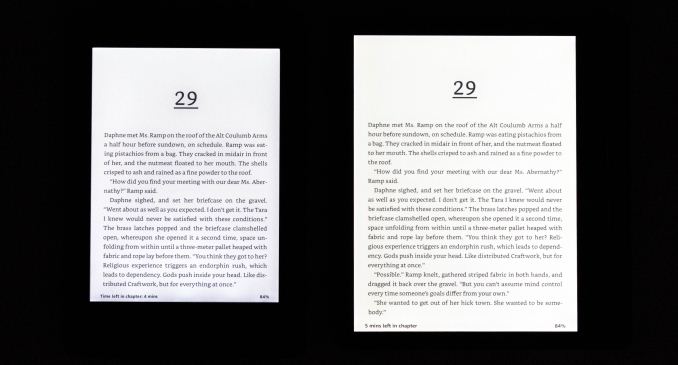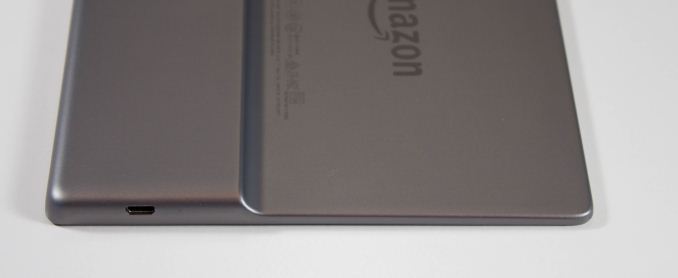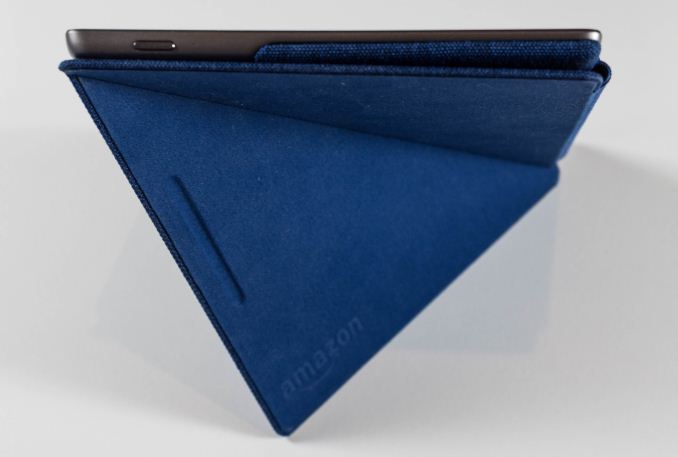The Amazon Kindle Oasis (2017) Review: A Premium Take On The E-Reader
by Brett Howse on January 25, 2018 8:00 AM EST- Posted in
- Accessories
- Amazon
- Kindle
- e-ink
- E-Reader
- Kindle Oasis
Reading with the Kindle Oasis, & Final Thoughts
We’ve gone over how the new Kindle feels in the hand. We’ve looked at how the new, larger display compares to previous Kindles and the current generation. But how does it work as an E-Reader?
As a Kindle customer for a long time, it’s taken a bit to get used to the new design. The way you hold a Paperwhite is not the same way you hold an Oasis, thanks to the asymmetric design, and it’s taken over a month to get used to holding the book on the side. I had previously always held them on the bottom, which sounds like a small thing, but it was a big change for my muscle memory. After a couple of months, it feels more natural now, and now using the Paperwhite seems a bit strange. If you wanted to hold it on the bottom you can just flip the orientation of the text in settings and hold it in landscape. I did try this, although the screen was almost too large for landscape, and my eyes had to move too much to get to the end of a line. Once again, muscle memory. After a couple of months, the feel of the Oasis has grown on me, and the benefit of holding it with one hand, which also can hit the page turn buttons, works very well.
One thing you do notice right away is the reduction in weight. The Oasis, despite its larger dimensions, is lighter in the hand, and that reduction in weight is magnified by the larger size, and the design. Since most of the weight is in your hand, rather than spread out evenly across the device like a Paperwhite, the Oasis feels much lighter than the Paperwhite. Fatigue from long reading sessions is reduced.
The larger display is fantastic as well. You can fit more text on the page, so page turns are reduced, but when you do need to turn a page the new processor gets the job done much more quickly than the Paperwhite. Thanks to the thinner bezels on three of the sides, the larger display doesn’t feel like it makes the Oasis much bigger than the Paperwhite either, although it is an entire inch wider.
The new 12 LED lighting system has also been a treat. The Paperwhite does fine, but there’s some unevenness to the brightness. The Oasis has a very uniform display, and the added features of automatic brightness are handy, although not always wanted. Luckily you can disable the overall automatic brightness, but leave the automatic dimming enabled, so you can read in the dark and the display will drop the brightness over time.
 Kindle Paperwhite (left) vs Kindle Oasis (right) in the dark
Kindle Paperwhite (left) vs Kindle Oasis (right) in the dark
There’s other E-Readers on the market, but if you’re in the market for a Kindle, you’re likely after the Amazon ecosystem, so the Oasis really needs to compete against the rest of the Kindle lineup. The $80 base Kindle should be ignored. The lack of lighting is a real detriment to it, and it has the lowest resolution E Ink display of the lineup, at 167 PPI. If you’re after a Kindle the Paperwhite is likely your best starting place. Amazon lists it at $119.99, but it’s often on sale for $99.99. Even at $40 more than the base Kindle, I think it’s worth it, but if you can get it on sale, it’s well worth the $20 upgrade. You get lighting, and you get a higher resolution display.
The Voyage sits in a strange middle ground now, and what used to be the top-of-the-line Kindle now costs $80 more than the Paperwhite, but isn’t the top of the line model. It has the same 6-inch display as the Paperwhite, although it increases the LEDs from 4 to 6, and has adaptive brightness. It’s also 30 grams lighter than the Paperwhite, and has page-press buttons like the Oasis. It feels like it’s a steep premium over the Paperwhite, for a nicer model that’s not quite the best Amazon has to offer.
The step up to the Oasis adds a lot of features, but also quite a bit to the price. At $249.99, it’s over twice the price of a Paperwhite, and over three times the price of the base model. If you go for the larger capacity model, add cellular, and don’t go for the “Special Offers” advertising, the max price Oasis is a staggering $349.99. That’s easily quality tablet territory, and is an awful lot for a niche device like a Kindle.
The Oasis does add a lot of functionality though. The larger display is fantastic, as is the better lighting. The addition of Bluetooth support means you can use the Oasis to play back audiobooks. The IPX8 rating means you can drop it in the pool and it will still work, which is not something you can say of any other Kindle.
To me, my Kindle Paperwhite is likely one of the best pieces of technology that I own. It’s rare to get a device that is so good at what it’s designed for. Being designed for just one task lets the device be perform very well at that task, and for me, an single-use device is appreciated. Reading on a tablet or a smartphone is just not as enjoyable, thanks to the LCD display, and the distractions of a smartphone.
Another advantage of the Paperwhite is that the price, at close to $100, makes it a much easier to replace item. If you’re a person that sometimes forgets their Kindle in the pocket of an airline seat, you probably will want to steer clear of the much more expensive Oasis. I wouldn’t call the Paperwhite disposable, but it doesn’t hurt as much if you do lose it or break it.
This is the dilemma with the Kindle Oasis. It’s very nice to use. It has a fantastic display. The aluminum feels great in the hand. But it is twice the price of a Paperwhite, and I love my Paperwhite. The Oasis starts at $130 more than a Paperwhite, and that's a lot of books. But, If you really enjoy reading, and the price doesn’t bother you, the latest top-end Kindle is a fantastic reading device, and you’d have a hard time finding a better E-Reader.












93 Comments
View All Comments
mode_13h - Sunday, January 28, 2018 - link
Huh. Not sure if I should wait and buy it from them... or maybe they'll do some cost reductions that end up annoying me. Walmart will "help" vendors cost-reduce their products, even going so far as to negotiate with their suppliers and component vendors for the units Walmart purchases.Threska - Sunday, January 28, 2018 - link
They'd have to give it a different SKU then. Part of the reason people get bitten, and remember Wal-mart isn't the only one who does this, is they don't pay attention.romrunning - Friday, January 26, 2018 - link
@Carmen00:In regards to not including Kobo, the article title clearly states the review is about the Kindle Oasis (2017). If you want a review of the Kobo models, look for one of those.
Don't try to fault the reviewer for doing exactly what he said the article was about. Now if this review was entitled "A Review of Ebook Readers", then you could fault him.
mode_13h - Saturday, January 27, 2018 - link
Perhaps you haven't read many reviews on this site, but they often feature comparisons with comparable products. This is true of most product reviews, since they're intended to answer the question: "do I buy this?", with the possible answers being: "yes", "no - something else", and "no - save your money". It's not like Oasis is a completely one-of-a-kind product, with zero alternatives on the market.mode_13h - Saturday, January 27, 2018 - link
I'll add that failing including meaningful comparisons puts it at greater risk of simply turning into a sales pitch.Carmen00 - Sunday, January 28, 2018 - link
Got to stick strictly to the title, right? Following that line of thinking, articles about Ryzen should clearly not be mentioning Intel chips, articles about Huawei's latest and greatest shouldn't be mentioning Samsung's products, and so on! It's standard practice to make some comparisons with the relevant competition, and Kobo is both quite relevant and very competitive in this niche. That is why I took exception to the particular statement that I quoted: it makes it appear as though there isn't such competition. I take Brett's point that this is just his own experience, but that said, perhaps he could take the opportunity to broaden that experience so that this kind of review is better and more useful to Anandtech readers.drothgery - Friday, February 2, 2018 - link
It's almost impossible to overstate how dominant Amazon's market position is in eBook sales. If a device doesn't have a Kindle app, it's basically useless as an ebook reader except for the tiny portion of the market that jailbreaks books or uses alternative stores.mode_13h - Friday, February 2, 2018 - link
You can buy ebooks directly from publishers. O'Reilly and InformIT provide PDFs, MOBI, and EPUB - all of which are supported by Kobo Aura ONE. For my needs, this is enough.Kobo is fairly popular outside the USA.
All of this is to say that people should *look* and see if they can find the titles they want, for other e-readers they might be interested in using. Don't simply assume that Amazon is the only way.
reckless76 - Thursday, January 25, 2018 - link
I bought the original Oasis, and I loved it. Felt great, looked great.. The problem was it was just too fragile. It slipped out of my hands while I was sitting down, reading on the porch. When it hit the ground, the case went flying off and the screen cracked. I'd only had it about 6 months. So I went back to the paperwhite. I can be as rough as I want with it and it's fine.Alexvrb - Friday, January 26, 2018 - link
My dad has the second-gen Oasis and it's pretty darn nice. A lot nicer than the first-gen Oasis. Also doesn't have the split battery design of the first gen either (which in hindsight had issues like the case flying off). Though I would still recommend the case for protection and grip.I will say the build quality of his first-gen Voyage was also meh. So maybe just avoid the first-gen models. :P